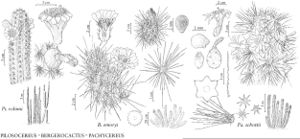Pilosocereus
Cact. Succ. J. Gr. Brit. 19: 66. 1957.
| Taxon | Illustrator ⠉ | |
|---|---|---|
 | Pilosocereus robinii Bergerocactus emoryi Pachycereus schottii | John Myers John Myers John Myers |
Trees or shrubs, erect to ascending or reclining, usually branched in basal portion, older plants with closely parallel, erect branches forming narrow crown; trunk absent or present, 8–12+ cm diam. Roots diffuse. Stems unsegmented, green to bluish or blue-green, columnar, [0.5–] 3–10 m × [2.8–] 5–8 cm, glabrous; ribs 3–30, low, rounded, furrows straight [or wavy], rib crests sometimes notched between areoles [ribs strongly tuberculate in 1 Brazilian species]; areoles usually closely spaced along ribs [often confluent in flowering region], circular to elliptic, woolly; hairs usually white or tawny [to blackish] soft, to 8 [–50] mm, longest on flower-producing areoles along each rib or on one side of stem in distal region; areolar glands not apparent; cortex and pith extremely mucilaginous. Spines 6–31 per areole, yellow [to brown or black], often aging gray, acicular, straight, terete, [2–] 10–15 (–25) [–40] × 0.25 mm, smooth; radial and central spines not distinguishable. Flowers nocturnal or crepuscular, lateral to subterminal on stems, from closely adjacent or confluent areoles, funnelform to narrowly campanulate, [2.5–] 5–6 [–9] × 2–5 [–7] cm; flower tube straight or slightly curved; outer tepals greenish [blue, red, or purplish], margins entire or minutely denticulate; inner tepals white [pinkish to reddish], 9–26 × 7.5 mm, margins entire; ovary smooth, scales absent (or 1–2), spines absent; stigma lobes usually 8–12. Fruits dehiscent along 1 side or apparently indehiscent, red or purple [to blue-green], [spheric or] depressed-spheric [to ovoid or oblong], 20–45 × 30–50 mm, fleshy, scales and spines absent (rarely 1–2 scales); pulp color variable; floral remnant usually persistent. Seeds black or dark-brown, snail-shaped, 1.2–2.6 mm, smooth, shiny; testa cells flat. x = 11.
Distribution
Fla., Mexico, West Indies, Central America, South America
Discussion
Species ca. 40 (1 in the flora).
The name Pilosocereus was created to replace the illegitimate name Pilocereus, which was earlier applied to this genus. Cephalocereus Pfeiffer, also formerly misapplied to the North American species, is now recognized as restricted to southern Mexico (W. Barthlott and D. R. Hunt 1993; E. F. Anderson 2001), although generic boundaries continue to be the subject of debate.